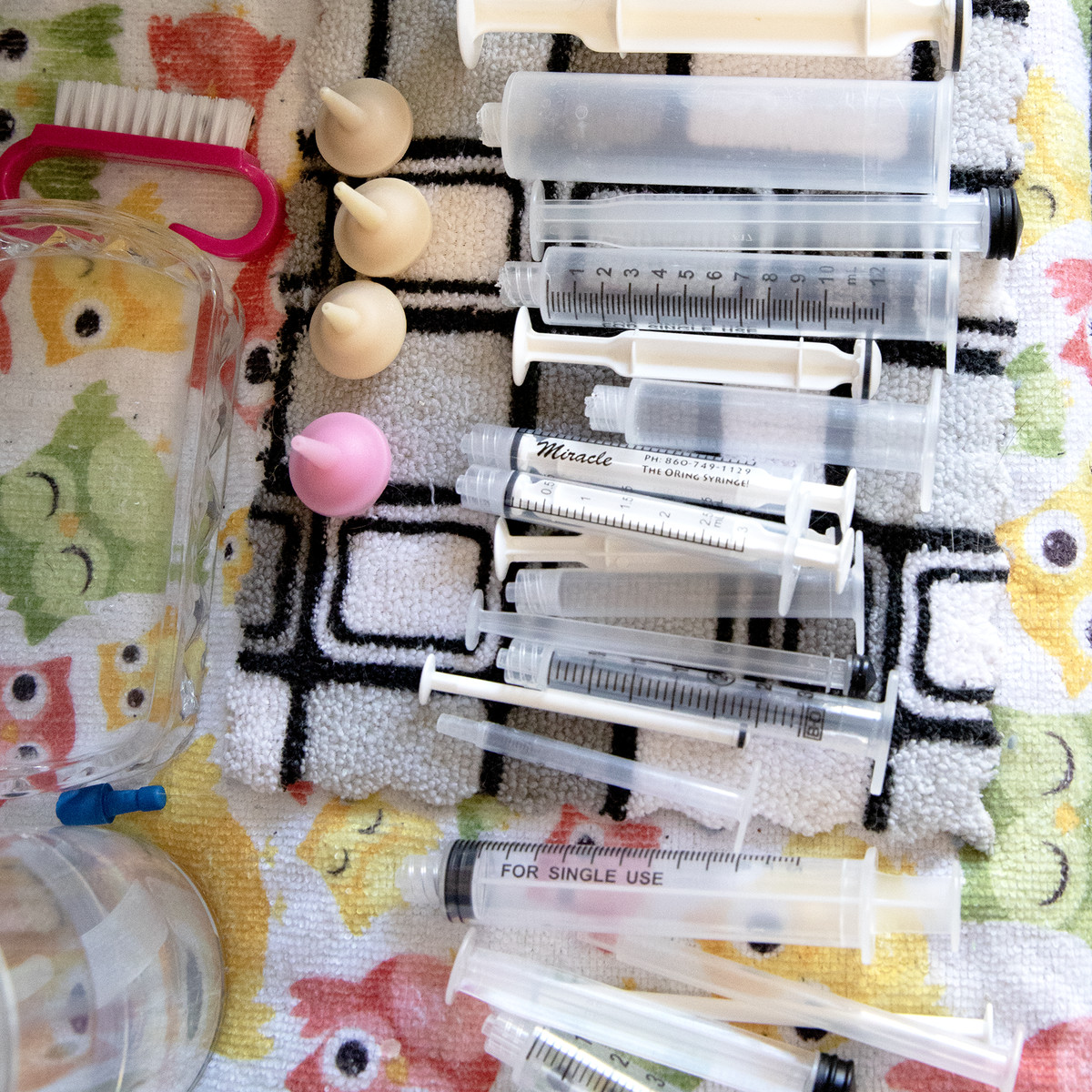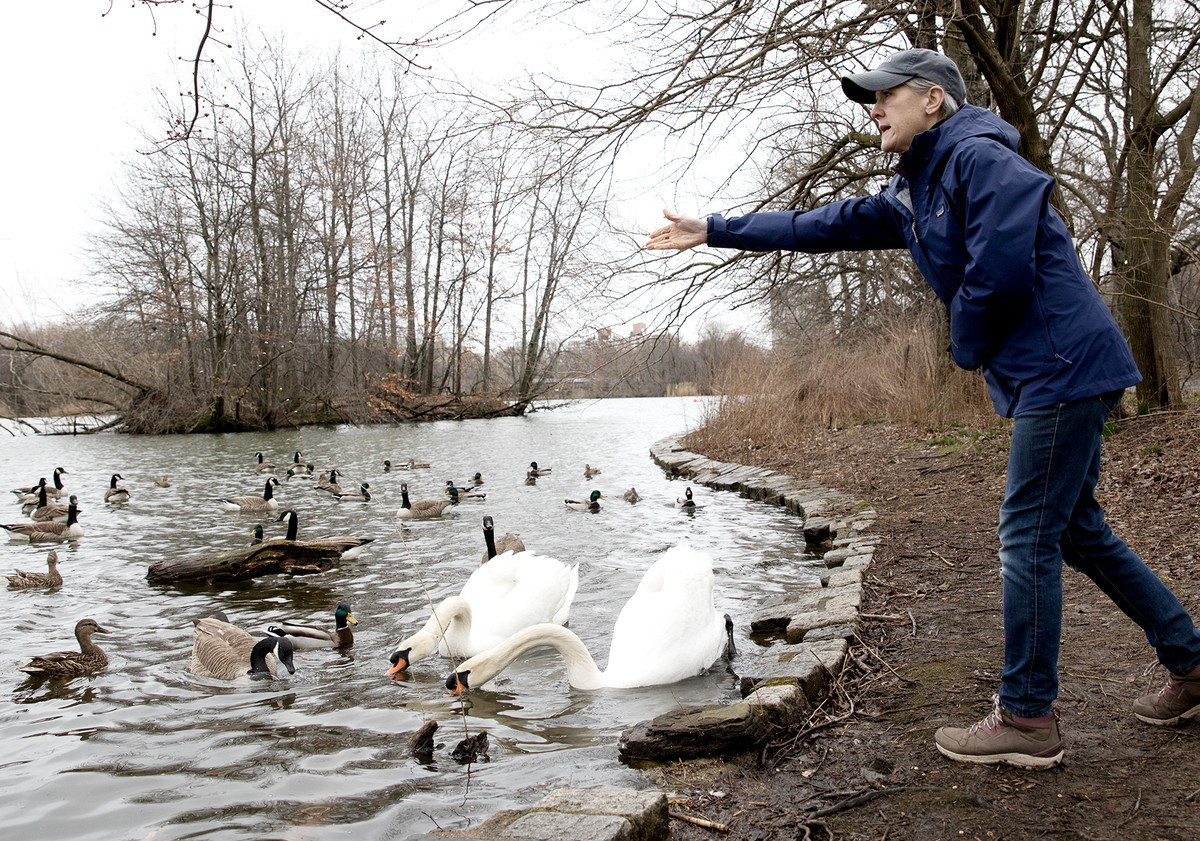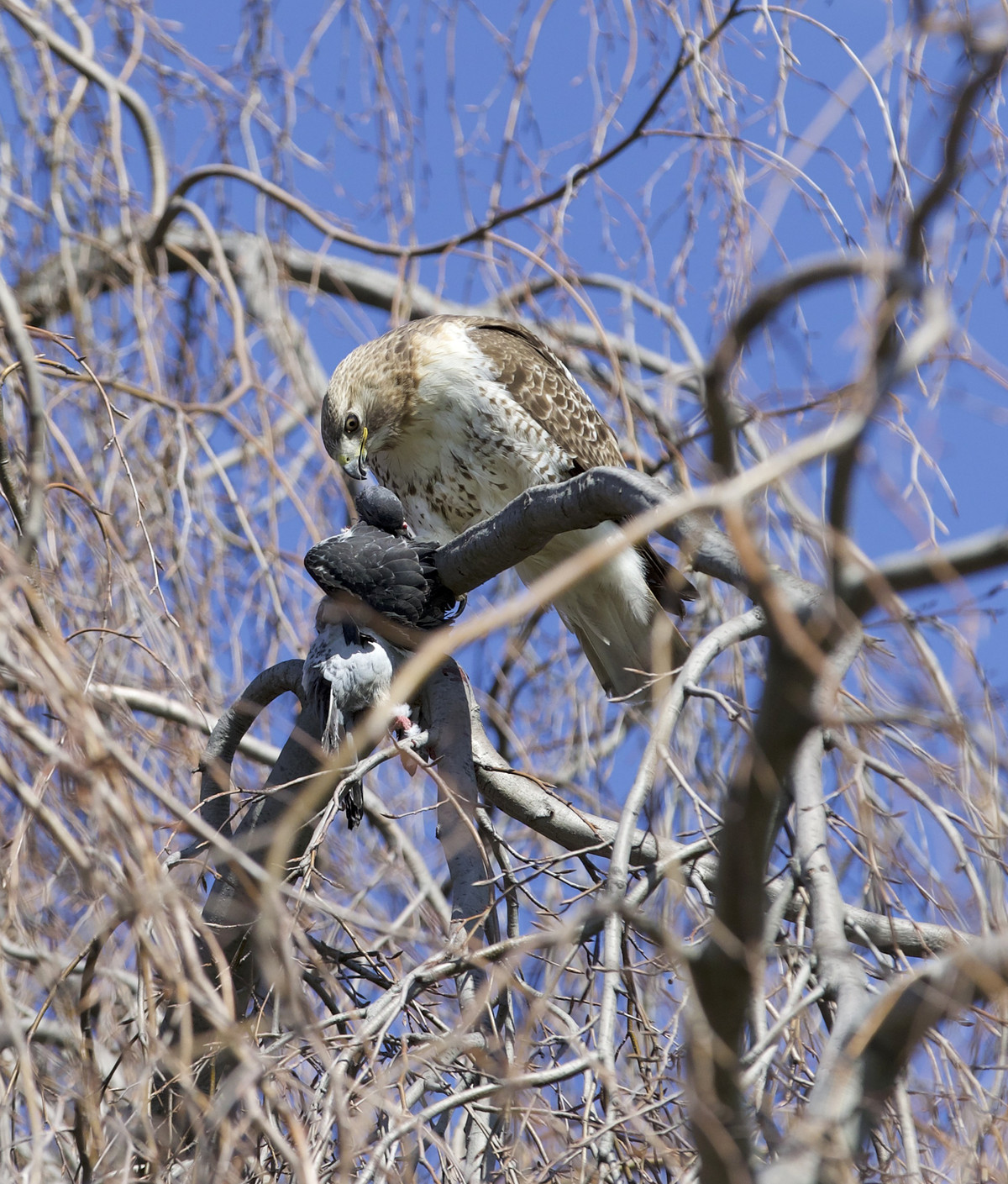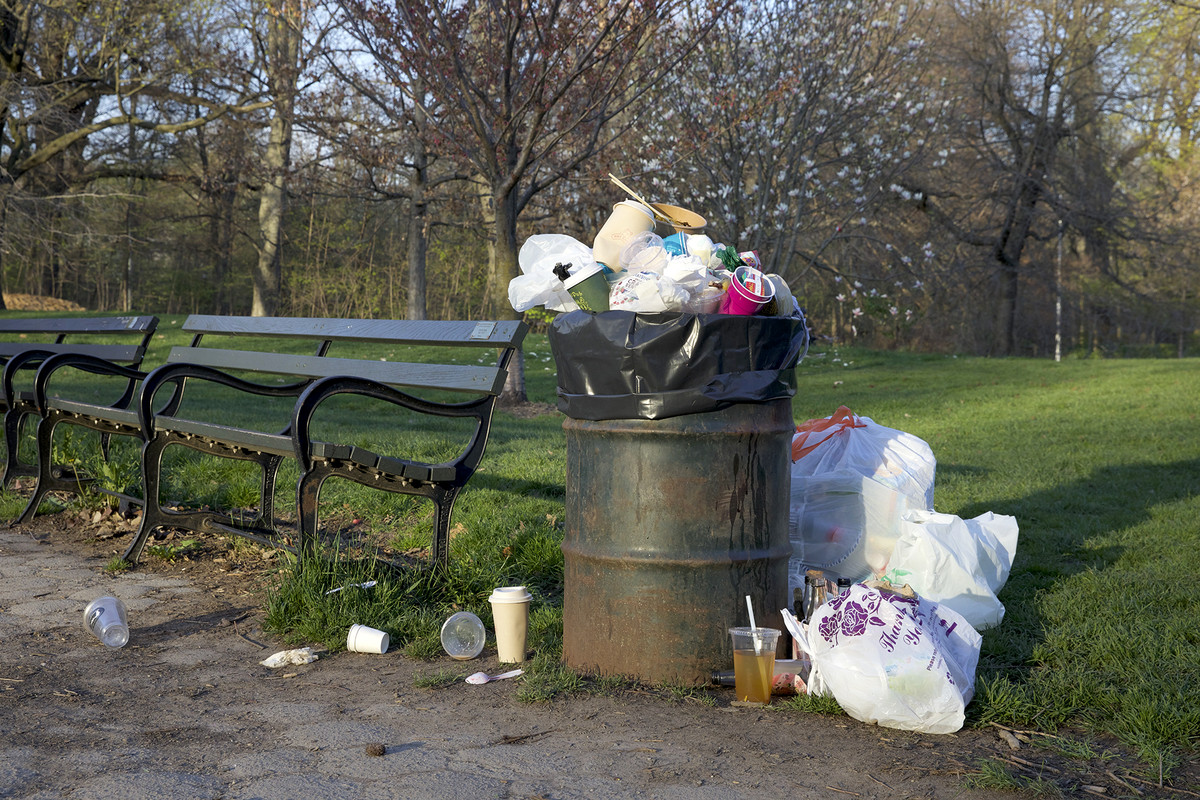 Technology
Technology  Why these New Yorkers are filling their apartments with squirrels, opossums, and pigeons
Why these New Yorkers are filling their apartments with squirrels, opossums, and pigeons April 22, 2024:
BAY RIDGE, New York City — One sunny afternoon in March, Amina Martin answered the phone in her small Brooklyn apartment. On the line was a taxi driver, who told her he had a pigeon in his backseat and was heading her way. The bird needed Martin’s help.
In New York, you never really know who your neighbors are. You might worry they have bedbugs or hoard cats. Maybe they’re celebrities. Or perhaps their apartments are filled with opossums, squirrels, and birds, all rescued from the streets of NYC.
Martin, a Russian immigrant, is that neighbor.
Her studio is full of pigeons, morning doves, and a handful of other stray birds including an African gray parrot named Elmoar. The animals are in cages that line the wall in front of her bed. Some of the birds have broken wings, trouble walking, or are partially blind. Others are abandoned pets with little chance of survival in the wild.

It was loud in her apartment when I met her that afternoon — a racket of coos and cheeps and the occasional interjection from Elmoar. “He’s teaching me English,” Martin jokes, adding that he says words like “whatsoever” that she’s had to look up.
Martin let out a couple of pigeons who flew around her apartment, including her favorite bird, named Anfisa. The animal had ombré gray plumage with pops of iridescent purple and green (i.e., she looked like a pigeon). “She’s in love with my husband,” Martin told me. “She lays eggs on his pillow because she thinks he’s her boyfriend.”
Martin is among a small number of people across the New York City boroughs who rehabilitate injured creatures that many other people label as pests. The driver who called Martin had brought birds to her before; an acquaintance of hers finds injured pigeons on the street and calls the same one or two taxi drivers to deliver them. (Sending birds via taxi? “It’s a common thing,” Martin says.)
Over several weeks this spring, I met more than a dozen licensed wildlife rehabilitators (aka, “rehabbers”) in New York. Many of them, like Martin, care for animals at home, turning their living rooms into makeshift wildlife hospitals. I visited a duplex in Staten Island full of squirrels and rats; a room in the Upper West Side with a box of baby opossums; and a small park on Roosevelt Island with injured Canada geese, adult opossums, and house cats, all living together and in some cases sleeping side-by-side. One rehabber in Manhattan told me she converted her balcony into an atrium for injured birds.
Top left: A four-week-old opossum getting ready to be fed. Top right: Rehabber Amanda Lullo holds a friendly wild rat she’s caring for. Bottom left: A young squirrel sucking down animal infant formula. Bottom right: A baby opossum in a furry sack.
New York’s rehabber community is small; the opossum, pigeon, and squirrel people tend to know each other. Some of them, like Martin, document their work on Instagram, amassing a hefty following. But many of them operate under the radar to avoid unwanted attention from the Department of Health, or their landlords. (A bedroom full of squirrels is typically beyond a building’s pet policy.)
You might be thinking: What are they thinking? People are commonly disgusted by the animals that have adapted to live alongside us — to eat our garbage, to sleep in our streets. We typically want them out of our homes, not in. Wild animals, no matter the species, can also be noisy, dirty, and sometimes diseased. (One of Martin’s pigeons pooped on her bed, and of course, I sat right in it.)
What’s even more puzzling is that most of these rehabbers work for free, often around the clock, to care for these animals until they’ve healed. They often spend what little money they have on feed, specialized equipment including syringes and IV bags, and medicine. One rehabber told me that she can’t afford to buy herself new clothes. “I’m so broke right now,” they said. “All of my money goes to the animals.”
As I spent time with rehabbers, I began to see their perspective. They view these species not as pests but as part of nature — as part of the New York City ecosystem. As part of their home. These animals belong here, rehabbers told me, just as much as we do. And they don’t deserve the harm that humans so often inflict on them, whether deliberately or not.
By showing these animals some respect and helping them survive, rehabbers appear to feel more connected with their environment, with what they see as nature. That enriches their lives and makes them feel less alone.
Maybe they’re onto something.

Nearly every inch of New York, the nation’s largest and densest city, has been transformed by humans. Even its parks are largely artificial: The ponds, streams, and waterfalls in Manhattan’s Central Park, for example, are fed by city drinking water.
Yet the city is brimming with non-human life.
On a warm evening in March, I strolled through Central Park and saw a few dozen raccoons, several of which were eating a large pile of spaghetti. I put a motion-sensing camera in Brooklyn’s Green-Wood Cemetery (where conductor and pianist Leonard Bernstein, among other icons, is buried) and it captured videos of groundhogs, skunks, opossums, and stray cats. The city’s ponds are full of turtles. There are even seahorses in the Hudson River, once a dumping ground for chemicals and dead bodies.
“I see nature everywhere in New York City,” says Dustin Partridge, director of conservation and science at NYC Audubon, one of the leading environmental groups in the city.


Some of the city’s animals are native to the region and have found ways to survive, even as developers chop up and pave over their habitats. Staten Island is still home to a rare amphibian called the Atlantic coast leopard frog, once common in Brooklyn, Queens, and Long Island. Around full and new moons in late spring, horseshoe crabs — ancient creatures that have been on Earth for hundreds of millions of years — still come ashore on NYC beaches to find mates and lay eggs. Islands in the harbor are home to loads of water birds like black-crowned night herons and egrets.
Many other species, meanwhile, are here in New York, in large part, because of us — or because they tolerate us. The wild ancestors of pigeons, which are domestic birds, lived on cliffsides. These days they’re happy to nest on the sides of buildings. Of the several million tons of trash the city produces each year, the occasional overflowing receptacle or torn trash bag provides ample food for rats and raccoons.
Images captured by a motion-sensing camera installed on a trail in Green-Wood Cemetery, in South Brooklyn.
These furry city slickers don’t fit neatly into any of our categories for animals, says Seth Magle, who runs the Urban Wildlife Institute at the Lincoln Park Zoo in Chicago. They exist somewhere between domesticated pets, like cats and dogs, and wildlife, like wolves and bears. “They occupy this invisible space in peoples’ heads,” Magle told me.
And that many of New York’s most common critters are not native to the region further complicates our feelings toward them. The pigeons evolved in Europe and North Africa, and the rats are from Asia. House sparrows and European starlings are native to the eastern hemisphere. Even the squirrels, which technically are native to New York, were artificially introduced to the city in the 1870s, after hunting and deforestation wiped out their resident population.
The plight of these common city animals is that they are so widely unloved. We treat them as if they don’t belong here, in our home. Even if they’re native to New York, we don’t want them in our city. Cities are for humans. Distant forests — environments that we can visit at our leisure, on our own terms — are for them.

In reality, we’ve already taken most of the planet for ourselves. Only a fraction of those distant forests remain. That’s why an estimated one million plant and animal species are now slipping toward extinction. The animals that are plentiful in cities like New York, these “pests,” are “winners on a planet full of loss,” as environmental author Bethany Brookshire wrote in her 2022 book Pests. Their abundance is, in a way, a success story.
To be clear, building a home for humans in New York has heavily degraded the natural ecosystem; the city has, for example, lost 99 percent of its freshwater wetlands. From another perspective, however, cities like New York have created a new ecosystem — a new web of life.
On any given day in late spring or summer, Arina Hinzen might be wearing a scarf around her neck full of baby opossums. Just as these marsupials cling to their mothers in the wild, the babies — some no larger than a ping-pong ball — cling to the fabric, like an animal print come to life. The animals seem to enjoy riding with Hinzen as she moves about. If they smell something delicious, she told me, the babies poke their snouts out for a whiff.
Hinzen, a licensed rehabber who runs a wildlife welfare group in the city called Urban Wildlife Alliance, is what you might call Manhattan’s premier opossum godmother. In the last decade, the German native has rehabbed roughly 1,500 animals, including hundreds of baby opossums, she said. A single female opossum can give birth to more than a dozen infants, each no larger than a jelly bean. If just one mother gets hit by a car, as is common in NYC, they’ll all be in need of life support. Often, when people find them, Hinzen is who they call.

Raising baby opossums — which differ from possums, an entirely different marsupial native to Australia — was not always her life. Nor has it been her most unusual vocation. As a young adult in Germany, Hinzen spent more than a decade judging skydiving competitions. Parachuters would hurl themselves from planes, sometimes do tricks in the air, and then try to land on a target. (She, herself, has jumped from a plane close to 500 times.) From there, Hinzen pursued a career in viticulture, got married, and built a wine importing company in NYC with her then-husband.
Years later — now more than a decade ago — Hinzen’s marriage and her company fell apart, she told me, as we shared a bottle of wine on a bench in Central Park. Her world crumbled.
It was around that time, Hinzen says, that she came across an injured pigeon in the Upper West Side. The bird was puffed up on the steps of a church and looked emaciated. Hinzen felt an urge to help. “It seemed like she had already checked out and given up on life,” Hinzen told me. “I think that’s what drew my attention, because I felt almost the same.”


Hinzen brought home the debilitated bird and with help from a local rehab center, nursed it back to health. She released the pigeon — Richard — a few months later. “To see that you can bring something back from the edge of death that has lost all hope ignited my passion,” she told me.
Hinzen, a Buddhist, rescued more pigeons in the months that followed, eventually graduating to infant squirrels and opossums. They have become her specialty. In the spring, Hinzen told me that she might have 40 babies at one time and be tending to them 18 or 19 hours a day. “It has completely taken over my life,” she says.
In these creatures, Hinzen, like other rehabbers, sees something that many of us don’t: something relatable. “I’m absolutely convinced that these animals have an emotional life,” she says. “At the end of the day, all they want is to live, to bring up their families, and to eat. They want the same as we want.”
Feeling a connection with these animals, and compassion for them, has enriched her life in the city, she says. Even just noticing them more — their quirky behaviors, their bizarre features — can inspire awe, she says.
“We are conditioned to see ourselves as different from other living beings,” Hinzen told me. “We have lost a feeling of connection to them. We have forgotten that we are part of nature and part of an ecosystem as much as they are.”

Amanda Lullo, a squirrel rehabber on Staten Island, echoes some of that thinking. “Everything serves a purpose,” she told me. Rats are “nature’s garbage disposals,” she says, and squirrels are “nature’s gardeners,” since they bury seeds that grow into trees — at least when they don’t retrieve them to eat later. “We need these animals,” she says.
I visited Lullo’s home on two separate occasions this spring. It’s a modest duplex that looks pretty ordinary. Until you walk inside. About two dozen cages, filled with squirrels, rats, and a couple of ferrets, were stacked up against the walls. An IV hung from the ceiling. A handful of pet cats and a rescued pit bull roamed around — and, in one case, slept on top of — the cages, remarkably disinterested in the animals inside.
As we walked around her home, Lullo, who grew up in Brooklyn, introduced me to the animals. There was Pistachio, a.k.a. Fat Boy, a pudgy squirrel who fell from a tree as a baby. The fall broke his arm and cracked his tooth, she said, as the animal (now mostly healed) crawled around Lullo’s body. Lullo also showed me several baby squirrels including a five-week-old; she feeds them a special animal infant formula with a dash of heavy cream using a syringe.


I also met a couple of wild rats, most named after fruits, including Strawberry and Blueberry. (Lullo raised them from infancy. Sometimes when people kill rats they find out that they have babies, Lullo said. They feel bad and call a rehabber.)
Though common, these animals are deserving of care, Lullo says. “Humans kill and destroy everything they touch,” she says. The animals of New York City, she explains, are mostly harmless and they just want to live.
Once rehabbers start caring for injured wildlife, they also just find it hard to stop. These people see critters in need everywhere.

“Once you know, you can’t unknow,” said Mary Beth Artz, a rehabber and stage actor who rescues ducks and other birds from Prospect Park in Brooklyn. (She’s currently rehabbing a jumbo Pekin named Freddie at her home. Last fall, the duck, which may have been purchased as a pet, was abandoned in a Queens parking lot, she said.)
“I say it all the time — ‘I’m not going to do this anymore’ — but then something else happens,” Artz told me one afternoon in Prospect Park, while she was trying to rescue a domestic khaki Campbell duck that was dumped in the lake.
“If we don’t do it, who’s going to do it?”
An uncomfortable answer to that question might be, well, perhaps no one should. Indeed, there are some good reasons to limit the numbers of certain urban critters.
Raccoons and skunks can carry rabies and other diseases. Rodent infestations, meanwhile, are particularly harmful to people experiencing homelessness, Brookshire writes in Pests. Their constant squeaks can make it impossible to sleep. (I couldn’t find anyone, aside from Lullo, who is rehabbing rats in the city. Lullo doesn’t plan to release them. Similarly, rehabbers seldom rescue raccoons, which require a more advanced license.)
“Disease is always a risk with wildlife,” said Myles Davis, a city wildlife expert who manages NYC Audubon’s green infrastructure program. (That said, “You are never at risk of getting rabies from a raccoon,” he added, if you only observe it from afar.)

An overabundance of these animals can also interfere with efforts to protect the city’s rarer species — stoking longstanding tensions between animal welfare and conservation. Pigeons may be an important food source for native raptors, including the once near-extinct peregrine falcon, but raccoons and opossums eat the eggs and chicks of native birds, according to Partridge. This complicates the question of what belongs in an urbanized environment.
I raised these tensions with Catherine Quayle, a spokesperson for the Wild Bird Fund, the city’s most well-known and largest rehab center, mostly focused on birds. “Wildlife rehab is not a practice of conservation,” she told me. “It’s a practice of compassion.” To tell the public that some animals matter and other ones don’t “defeats our mission,” she said, “which is to teach people about wildlife.”
As Quayle sees it, showing compassion for any wild creature, whether it’s a pigeon pecking at a slice of pizza or a songbird flying through during spring migration, can engender more respect for the wild world at large. It can help erode the dividing line between humans and pests, ultimately making us better stewards of our environment.
We really need to be better stewards. Many features of the NYC built environment harm all animals, rare and common alike. Building windows are too reflective, causing birds to crash into them. Rat poison not only makes rodents suffer but harms the rodent-eating raptors. Flaco, a famous owl that escaped last year from the Central Park Zoo (with the help of a miscreant), died recently after colliding with a building. An autopsy revealed that he had four kinds of rat poison in his body (as well as a form of herpes found in pigeons).
This doesn’t mean we should throw up our hands and welcome these animals in with open arms. But maybe — just maybe — NYC could find a way to, you know, not place trash on the street in flimsy plastic bags. (The city says it’s working on it.) You may think urban animals are gross, but we are the ones filling the city with trash.


I still struggle with my own feelings toward these creatures. I happen to live on a rat-ridden street in Brooklyn. On a walk the other night, my dog lunged for a stray cat which then lunged for a large rat (and successfully snatched it). I’ve dealt with mice and bugs in my apartment. Last fall, I had to move because of a roach infestation. If this is the New York City ecosystem, I’m not sure how close to nature I want to be.
What is clear to me is the simple power of connecting with animals as individuals, of pausing even briefly to observe their lives. Watching house sparrows bathe in a grimy fountain or squirrels chase each other around a tree can, I’d argue, inspire awe. And to see them suffering can be incredibly painful.
That much was clear to me back in Bay Ridge, where I was waiting with Martin, the bird rehabber, for the pigeon delivery. A white SUV pulled up, and the driver retrieved a cat carrier from the backseat. Martin took the carrier and set it down on a nearby bench.
The pigeon inside was still and its eyes glossy; I could see its breast faintly rise and fall. It wasn’t doing well, Martin said. The bird was about to die. We sat there in silence, Martin lightly petting the pigeon’s back. And a moment later, the animal was completely still. It had passed away, Martin told me.
“You never get used to it,” she said, quietly.
Frankly, I was devastated. I’ve rarely given pigeons much thought, but at that moment — after witnessing life vanish — I was comforted knowing that these birds, and that so many other unloved creatures across the city, have people looking out for them.